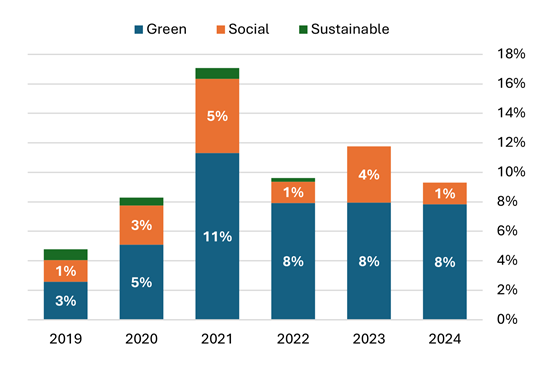Announcements
Drinks

Covered Bond Quarterly: Steady sailing over the summer with few clouds on the horizon
“We expect stable credit quality for banks and covered bonds for the remainder of the year,” said Karlo Fuchs, head of covered bonds. “At the same time, our expectations that credit spreads would widen as a consequence of the expiry of the Eurosystem’s purchase programmes did materialise, although the greater spread variance we expected is already looking like it is diminishing.”
Fuchs believes that the fact banks are able to fund longer to better match their long-term assets is credit positive: 54% of new covered bond issues YTD have had a seven-year-plus maturity. That compares to 23% in 2023, although it is still far from the 70%-80% between 2019-2021.
The EUR 9.5bn in ESG-themed covered bond issuance in H1 2024 stands at around half 2023 and 2022 volumes. “Assuming no sudden shift, we will see a similar volume in 2024,” Fuchs said. In relative numbers, about 10% of all issuance has been labelled green or social, unchanged from the picture since 2022.
ESG covered bond issuance
 Source: Bond Radar, Scope
Source: Bond Radar, Scope
The ECB has published climate-risk disclosures relating to its bond holdings, including covered bonds. For covered bonds it is not as easy to apply climate-risk considerations other than for the small share of ESG themed bonds. “What is lacking is consistent reporting on what makes covered bonds the high quality go-to investment: ESG data on cover pools,” Fuchs noted.
Meanwhile, there is less than six months to go before the updated ‘property value’ takes effect with CRR3 in January 2025. This could have a notable impact on covered bonds as market values are directly linked to the amount of bonds that can be issued. The property value cannot exceed the current market value or the average market value over the last six years for residential and eight years for commercial property. “Our analysis demonstrates that the Commission’s proposal to reduce the impact of cyclical effects on the valuation of property securing loans and to keep capital requirements for mortgages more stable works relatively well,” said Mathias Pleissner, deputy head of covered bonds.
European house prices show a positive trend, on average. Variations remain high, though, with some markets still showing price depreciation – in particular in Central Europe. “In the medium term, house prices in southern Europe may outperform as indicated by strong GDP growth and moderate value increases since the financial crisis,” Pleissner added.
Download the Covered Bond Quarterly here.
Stay up to date with Scope’s ratings and research by signing up to our newsletters across credit, ESG and funds. Click here to register.






